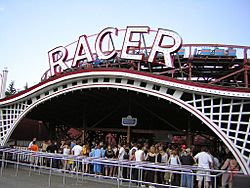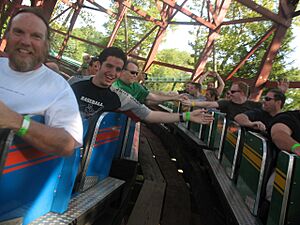Racer (Kennywood) facts for kids
Quick facts for kids Racer |
|
|---|---|
 |
|
| Kennywood | |
| Location | Kennywood |
| Coordinates | 40°23′13″N 79°51′43″W / 40.38694°N 79.86194°W |
| Designated: | 1995 |
| Status | Open |
| Opening date | 1927 |
| Cost | $75,000 |
| General statistics | |
| Type | Wood – Racing |
| Manufacturer | Charlie Mach |
| Designer | John A. Miller |
| Model | Racing |
| Track layout | Möbius Loop |
| Lift/launch system | Chain lift |
| Height | 72.5 ft (22.1 m) |
| Drop | 50 ft (15 m) |
| Length | 4,500 ft (1,400 m) |
| Speed | 40 mph (64 km/h) |
| Inversions | 0 |
| Duration | 1:32 |
| Capacity | 1400 riders per hour |
| Height restriction | 46 in (117 cm) |
| Trains | 4 trains with 4 cars. Riders are arranged 2 across in 3 rows for a total of 24 riders per train. |
| Racer at RCDB | |
The Racer is a super cool wooden racing roller coaster at Kennywood amusement park! You can find it near Pittsburgh in West Mifflin, Pennsylvania. This amazing ride was built by Charlie Mach and designed by the famous John A. Miller. The Racer first opened in 1927, making it one of the oldest roller coasters still running today! It has a special design called a Möbius loop. This means both trains ride on one continuous track. What's neat is that each train ends up back at the station on the opposite side from where it started!
The First Racer Coaster
Did you know there was an even older Racer? The very first Kennywood Racer was built in 1910. It was a side friction roller coaster designed by Frederick Ingersoll. This early version was also a twin-track racing coaster. It was designed by John A. Miller and cost about $50,000. When it was built, it was the biggest racing coaster in the world!
The original Racer had two trains that raced side by side. They ran on two separate tracks. But these trains didn't have wheels under the track. This meant the dips and curves had to be very gentle. Each train had three cars, and 18 people could ride at once. This first Racer was taken down in 1926. A new area called Kiddieland was built in its place.
How the New Racer Was Born
The Racer we know today was designed by John A. Miller in 1927. It was built by Charile Mach. The people at Kennywood really liked Miller's earlier work. So, they asked him to build a brand new twin or racing coaster.
One of the park owners, Brady McSwigan, wanted a "snappy ride." He wanted it to be fun but not too intense. He hoped mothers and children would enjoy it. This new Racer cost more than $75,000 to build.
The Racer's unique Möbius loop design is because of how the station is set up. When the trains leave the station, they turn away from each other. But when they meet again at the lift hill, they are on opposite sides! The tracks then stay together for the rest of the ride.
Unlike the first Racer, the new trains were locked onto the tracks. This allowed for exciting banked curves. It also meant the ride could have curves on the dips! In 1949, Andy Vettel made a change to the coaster. He removed the final hill.
Awards and Recognition
The Racer is a very special ride! In June 2010, it was named an "ACE Roller Coaster Landmark." This award came from the American Coaster Enthusiasts. It shows how important and historic this roller coaster is.
Images for kids




